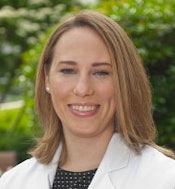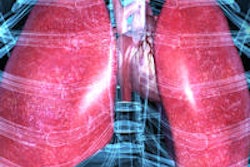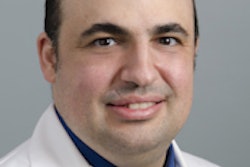
Primary care providers are often unaware of current guidelines on CT lung cancer screening, and they are ordering few scans for their patients at risk, according to a new survey in Cancer Epidemiology, Biomarkers and Prevention. Countering this trend is key if CT screening is to reduce lung cancer mortality.
The survey of more than 200 providers at a large academic institution found serious knowledge gaps regarding the benefits and indications for low-dose CT (LDCT) screening for lung cancer. Few ordered CT scans or sputum cytology, and in fact twice as many ordered a chest x-ray, which is not recommended as a screening test for lung cancer.
To top it off, fewer than half of the providers surveyed could cite three or more of the six components a patient should have to make them eligible for lung cancer screening, and more than one-third doubted CT's effectiveness for detecting early-stage lung cancer.
 Dr. Jennifer Lewis from Wake Forest School of Medicine.
Dr. Jennifer Lewis from Wake Forest School of Medicine."The study told us the important information that very few providers are performing lung cancer screening with low-dose CT, and that comparatively they're performing screening more often with chest x-ray than with low-dose CT," lead author Dr. Jennifer Lewis told AuntMinnie.com in an interview. Lewis is associate chief of internal medicine at Wake Forest School of Medicine.
The overall picture was one of "limited knowledge of guideline recommendations among primary care providers, which likely prevents providers from facilitating shared decision-making conversations about the potential benefits, harms, and uncertainties of lung cancer screening with their patients," wrote Lewis and colleagues including Dr. W. Jeffrey Petty and Dr. Kathryn Weaver (Cancer Epidemiol Biomarkers, January 22, 2015).
Cancer's toll, screening's hope
Lung cancer is the leading cause of cancer death in the U.S., responsible for some 160,000 deaths per year. Lung cancer screening with CT is still rare in the U.S., and as result only about 15% of cancers are diagnosed at an early stage when they are curable.
The National Lung Screening Trial (NLST) in 2011 reported a 20% lung cancer mortality reduction and a 6.7% overall mortality reduction in a high-risk cohort that was screened annually with LDCT for two years. Based largely on these results, several professional organizations have endorsed lung cancer screening, publishing guidelines that recommend annual LDCT.
In 2013, the U.S. Preventive Services Task Force (USPSTF) gave CT screening a "B" recommendation, which requires the Affordable Care Act to screen eligible patients as a free preventive service. This month, the U.S. Centers for Medicare and Medicaid Services (CMS) released its final decision memo on CT lung cancer screening, approving reimbursement for eligible Medicare patients ages 55 to 77 years.
But if mortality reductions are to be realized in the real world, high-risk individuals will need to rely on their primary care doctors to recommend and refer them for CT lung cancer screening. An estimated 8.7 million individuals are eligible for screening, with a potential of 12,000 lives saved per year, but the barriers to screening and the rate at which it will be ordered are unknown, and screening rates will likely be low if previous studies are any indication, the authors wrote.
"There have been studies showing that physician recommendations play a big part in whether patients want to get screened, so it's important that physicians be knowledgeable about lung cancer screening in order to have these shared decision-making conversations with their patients ... to decide whether screening would be a good thing for the patient sitting in front of you," Lewis said. "In order to even begin to have that conversation, our doctors need to be knowledgeable about lung cancer screening. So the main goal of our study was to assess whether primary care physicians were performing lung cancer screening with low-dose CT. It's about the modality."
The group developed a questionnaire to examine primary care providers' lung cancer screening practices, knowledge, and attitudes, and sent it to all primary care providers at a large academic medical center.
"We hypothesized that few providers would report ordering LDCT within the last year, other cancer screening tests would be perceived as more effective in reducing cancer-specific mortality than LDCT, and few providers would know consensus guidelines," Lewis and colleagues wrote.
In late 2013, the survey was sent to 488 primary care providers at Wake Forest Baptist Medical Center. It included items adapted from the U.S. National Cancer Institute's (NCI) colorectal and lung cancer screening questionnaire to assess lung cancer screening practices over the past 12 months for asymptomatic, high-risk patients who received chest x-ray, sputum cytology, or low-dose CT.
Eligible respondents included physicians, nurse practitioners, and physician assistants who provided primary care services to patients 40 years or older; however, interns in their first year of training were ineligible. Participants had a chance to win one of five $50 gift cards.
The survey also assessed the following:
- Knowledge of lung cancer screening recommendations. This included minimum smoking history, age requirements, screening frequency, and the eligibility of individuals exposed to secondhand smoke.
- Lung cancer screening barriers. Respondents rated potential barriers as major or minor, including false-positive findings, potential harm from unnecessary procedures, low perceived usefulness, and lack of evidence. Patient barriers including anxiety, concerns about radiation, lack of awareness of screening, and cost.
- Cancer screening beliefs. Respondents were asked about their perceptions of the effectiveness of other screening exams such as colonoscopy, mammography, Pap smear, and prostate-specific antigen testing. They were also asked to rate the effectiveness of each test.
- Future educational directions. Respondents were asked whether they were interested in continuing education regarding lung cancer screening, along with follow-up questions on the type of teaching and maximum training time.
- Provider and practice characteristics. Providers listed their position, years in training or practice, time spent providing care and in what field, and estimates of the percentage of smokers in their practices.
Lack of awareness
In all, 293 potentially eligible participants (60%) responded to the survey. Of this group, 212 provided complete responses and were included in the analysis. Three-fourths of the respondents were internal medicine specialists, 69% were 40 years or younger, and 70% were white, non-Hispanic physicians. Three-fourths provided direct patient care most of the time, and about 37% of their patients were smokers.
Just over half of the providers (53%) knew fewer than three of six guideline components for LDCT screening -- for example, that annual screening is recommended, that it should end at age 75 or 80, and that exposure to secondhand smoke alone is an insufficient reason to screen. One-fourth of the respondents didn't know any of the guidelines, the authors reported.
Even though knowledge of the guidelines was poor, most providers (88.4%) said that USPSTF is influential to their practice. The respondents also identified the American Cancer Society (71.8%) and the American Society of Clinical Oncology (46%) as being influential to their practice.
Preference for x-ray screening?
Interestingly, more than twice as many providers reported using chest x-ray (21.3%) versus CT (12.3%) for lung cancer screening. Ordering CT scans was significantly associated with knowledge of lung cancer screening guidelines, the team wrote. How did a nonrecommended test such as chest radiography become so popular for lung cancer screening?
"We were not able to find an answer to that question," Lewis said. "We looked at training of providers and number of years of practice to see if we could identify a pattern [among those ordering x-ray], but none of it panned out. I suspect it has to do with costs, as chest x-ray costs a lot less than CT. I think that maybe the doctors want to screen them but the patients can't afford it."
Indeed, the respondents felt that the most common barrier to screening was patient cost (86.9%). This was followed by potential harm from false positives (82.7%), patients' lack of awareness (81.3%), the risk that incidental findings will require further workup or monitoring (81.3%), and a lack of insurance coverage (80.1%), the authors wrote.
Just 42% of participants rated LDCT as very or moderately effective for reducing lung cancer-specific mortality, and 28% considered LDCT minimally or not effective in reducing lung cancer deaths. One-third were unaware of LDCT's effect on mortality.
More education is needed
The results indicate that more education is needed for primary care providers.
"We clearly need to do more education about the results of NLST," Lewis said. "It seems they don't know about that study. The information has been out there, but it takes a while for it to start to come into practice."
Fortunately, almost 90% of respondents expressed an interest in learning more about LDCT for lung cancer screening.
As the survey results became known, Wake Forest doubled down on its efforts to improve physician awareness of lung cancer screening and its benefits, Lewis said.
"I am chief resident and partly in charge of the residency program, so I've started adding [lung cancer screening] to our ambulatory curriculum so that the residents as part of a two-year program will get 30 to 45 minutes of lectures on cancer screening," she said.
Working with the hospital's marketing department, the group has also developed pocket guides with lung cancer screening information and eligibility requirements so that providers can give them to patients either on paper or digitally to take home.
"We're definitely doing a lot to disseminate information, help patients learn about screening, and answer any questions they have," Lewis said.
The study is probably the first to report on lung cancer screening recommendations by primary care providers, the authors wrote. They noted a few study limitations, including its single-center design, its reliance on providers' recall of screening behavior, and the fact that many of the providers were less experienced and younger than 40.
As insurance coverage for LDCT becomes more common, future studies may want to examine lung cancer screening uptake using administrative databases and electronic medical records, the authors noted. And with the changes in laws bringing in more reimbursement, awareness and screening rates will certainly grow.
As for reimbursement and the problem of patients being unable to afford screening, "it's becoming less and less of a problem as CMS and Medicare begin paying for screening," Lewis said. "And it should become even less of a problem this year as private insurance companies are mandated to cover screening because of the grade B recommendation by USPSTF, based on the Affordable Care Act."




















